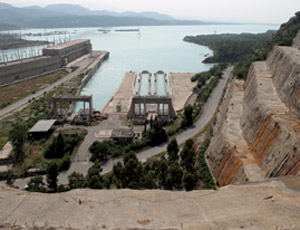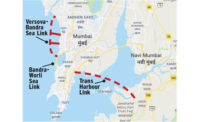Pakistan’s catastrophic floods this year overshadowed the Indus River’s pivotal role in irrigating the country’s farmland and generating its electricity. But even as river levees tumbled, engineers were completing plans to enlarge generating capacity of the Indus’ mighty Tarbela dam by 27% and to build the even larger Diamer Basha hydro project farther upstream.

Diamer Basha will be sited more than 300 kilometers upriver of Tarbela but will, nevertheless, boost the lower plant’s output by reducing sedimentation. Since Tarbela’s completion some 36 years ago, siltation in the river has reduced its reservoir capacity by nearly 30%, according to data from S. Tanveer Abbas and Izhar-ul-Haq, technical services department principals at the Water and Power Development Authority (WAPDA).
Without remedial action, in time sedimentation will reduce Tarbela to run-of-river operations, forecasts Francis Griffin, a director of Mott MacDonald Group, London. Mott MacDonald and Coyne et Bellier, Paris, are beginning a contract to optimise designs for Tarbela’s expansion and prepare documents for construction bidding, probably in 2012.
Built primarily for irrigation in an area approximately 100 km northwest of Islamabad, the 148-meter-tall, 3-km-long Tarbela dam includes two spillways and five water tunnels. Tunnels Nos. 1, 2 and 3 originally were dedicated for power generation and tunnels Nos. 4 and 5 for irrigation releases.
The plant started with four 175- MW units in a surface powerhouse at the end of tunnel No. 1. It was expanded by installing six similar units at tunnel No. 2 in the mid-1980s, notes Khursheed Anwar, WAPDA’s project leader. Four 432-MW units were built at the end of tunnel No. 3 in the early 1990s. At 3,478 MW, Tarbela accounts for some 20% of Pakistan’s total power generation.
WAPDA’s new, $500-million to $700- million project will split tunnel No. 4 downstream of the dam. The split will allow water to be used either for irrigation or to drive two additional 480-MW turbines, which are part of the project, located in a surface powerhouse. The water tunnel, now used solely for irrigation, operates for only a few weeks a year, says Griffin.
As well as providing new capacity, the project will increase efficiency of the plant’s existing units, says Griffin. Even with diameters of 13.5 m, the existing tunnels are undersized for the water flows, resulting in 20% head losses, he estimates. Operating the fourth tunnel in power mode will reduce these flow rates.
Furthermore, forecasts of Tarbela’s future output depend on sediment formed by drifting glaciers, far to the north, and flowing down the Indus into its 230-sq-km reservoir. “Siltation has been an issue with Tarbela since before it was constructed,” says Griffin. “The rate of [storage] volume loss has been a lot lower than anticipated.”
Already, the toe of the long, shallow slope of sediment reaches the water intakes, says Griffin. Because an earthquake, theoretically, could push the sediment forward, “we have to investigate putting a raised intake in,” he says.
Reducing sediment flows has been one of the benefits cited by WAPDA to justify the 4,500-MW Diamer Basha dam project, some 40 km south of Chilas. WAPDA officials believe that the dam could extend Tarbela’s useful life by as much as 35 years.
Diamer Basha’s roller-compacted-concrete dam will rise up to a 272-m crest height to create a 10-billion-cu-m reservoir. The dam will include a spillway with 14 gates. Further, its two underground powerhouses, on the left and rights banks, together will operate 12 turbines, each rated at 375 MW.
An international joint venture led by Lahore-based design firm NESPAK completed the feasibility study some eight years ago. WAPDA then hired a team led by Lahmeyer International GmbH, Bad Vilbel, Germany, for detailed design work, ending in 2008.
WAPDA will procure the project in five major contracts starting next year or 2012, aiming for completion by the decade’s end.
The authority has prepared contractors’ prequalification bid documents and will issue them after receiving approval from the Asian Development Bank for project loans. Meanwhile, early this summer WAPDA secured funds from the government to start buying land for the project.



Post a comment to this article
Report Abusive Comment